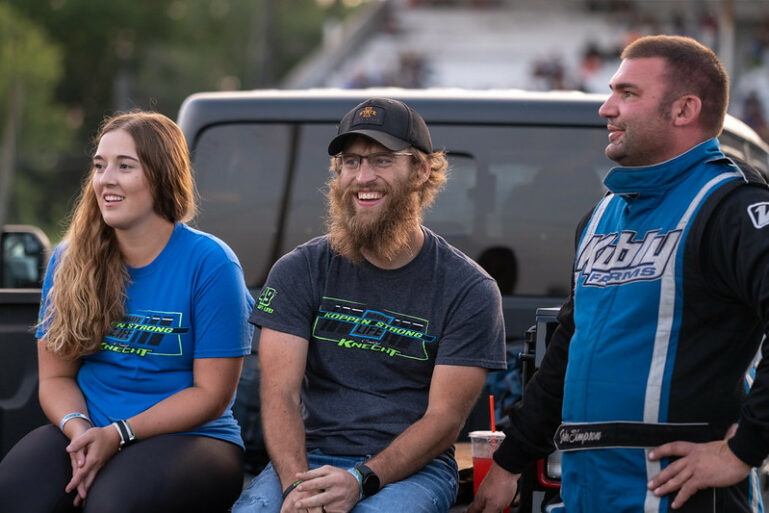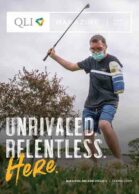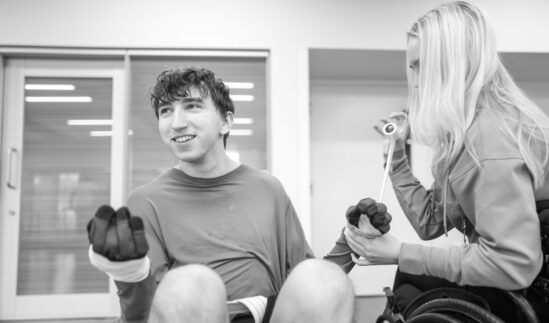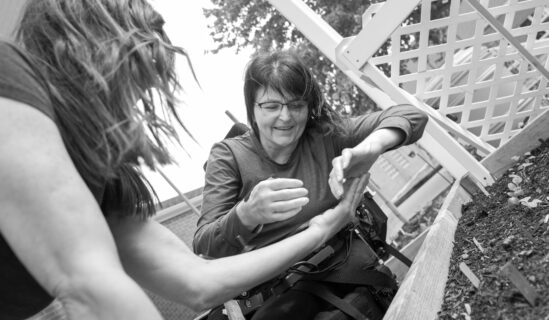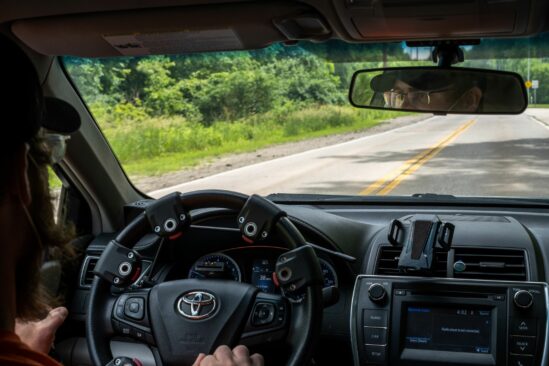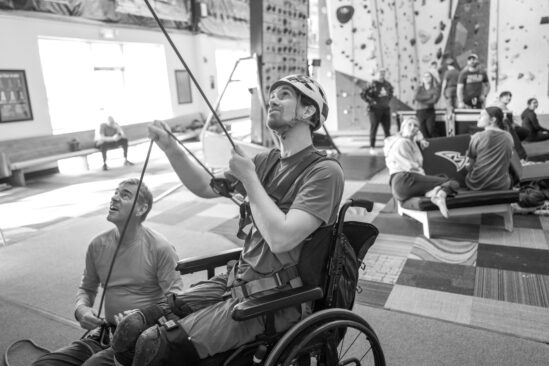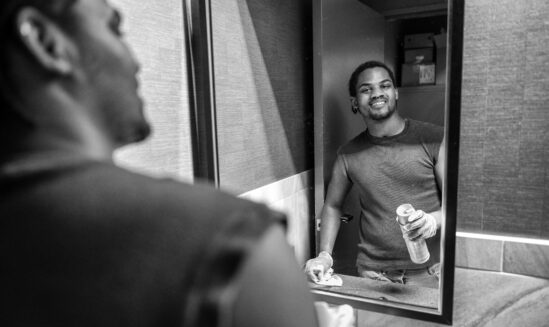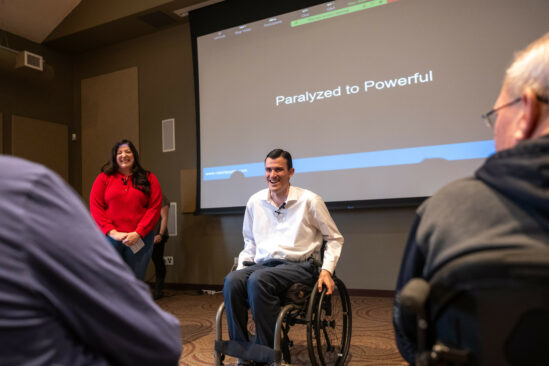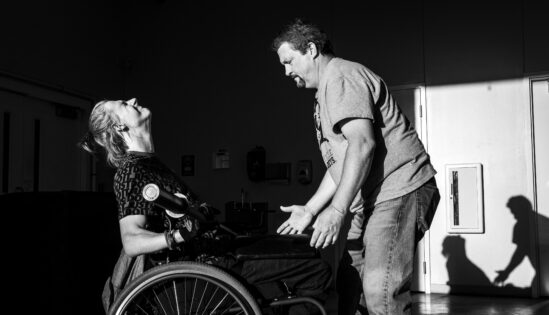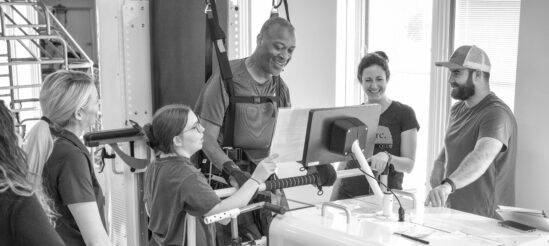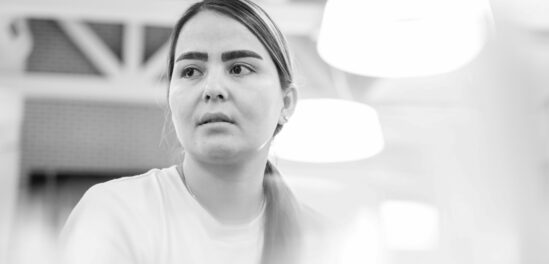Life sometimes throws a curveball. Or two. Or three.
Matt was home alone watching football. While watching, he realized his arm had fallen asleep, numb to the touch. The numbness didn’t subside. He was barely able to get ahold of his parents. To Matt, his explanation to his parents that he needed help made sense, but for them, Matt’s words came out as slurred and mumbling.
After a brief stay in the hospital for treatment of a stroke, Matt and his wife Kendra were told he had a congenital heart defect, something that would require a heart transplant within the next five years. To help monitor any irregularities in his heartbeat, Matt was given a LifeVest, which alerts for rapid heartbeats and can deliver a potentially lifesaving electrical shock.
Two months later, in December 2021, the second curveball presented itself. While at home, Matt’s LifeVest sounded an alarm. Taken to a local hospital, his heart was shocked back into a normal rhythm, but his condition didn’t improve. Transported from their town of Whittemore, Iowa to Sioux City, Matt went into advanced heart failure. Intubated, he would need to be transported via Lifeline to the University of Nebraska Medical Center in Omaha to receive a heart transplant. What originally was a five year advance notice turned to no time to lose.
Matt was transported to UNMC—with Kendra and family close behind. “I hadn’t slept for two days,” remembers Kendra. “He was very sick, and we weren’t sure how things would turn out from one day to the next.
“I met with his doctor and he told me Matt had a 50% chance of surviving the transplant. I hated his direct and honest tone, but as time went on I appreciated that he was so straight forward. You can’t get around what’s at stake.”
And Matt’s condition continued to worsen.
On December 11th, Matt and Kendra decided to get married in the ICU—around one month before the date they had originally set.
On December 14th, Matt was placed on the transplant list, receiving a heart the next day.
But the heart had traces of the COVID-19 virus—unsuitable for a transplant.
A day later, another heart was found.
On December 17th—Matt underwent the transplant surgery.
Within the span of ten days, Matt had experienced multiple organ failures, received two potential transplant candidate hearts, gotten married, and was seemingly reaching the end of hardship after hardship.
With a new heart he and Kendra could move forward—stronger.
But the curveballs were not finished.
…
“It’s called a spinal cord infarction,” says Matt. It is unknown when the infarction occurred, but following the transplant, Matt was paralyzed from the waist down.
The road to get back to life in Whittemore lengthened. Prior to his transplant, Kendra took a photo of Matt on the hospital bed, surrounded by tubes, sensors, and wires. When Matt reflects on the picture and the time before rehabilitation, he simply says:
“It’s what death looks like.”
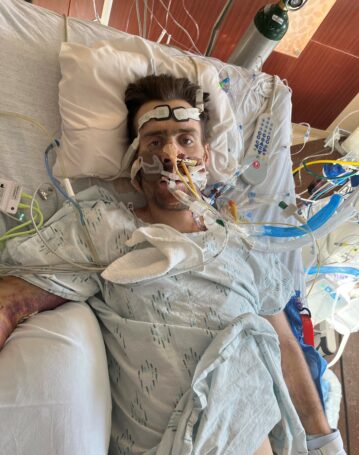
…
Following acute rehabilitation at Madonna Rehabilitation Hospital, Matt arrived at QLI in March of 2022.
“I don’t know if I’ll ever be able to walk without support again,” says Matt, “but at QLI it was never an answer of ‘yes’ or ‘no,’ but ‘let’s see.’”
Even if the ultimate answer to questions of mobility or strengt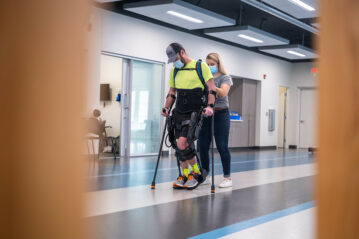 h would turn out to be limiting, that wouldn’t stop Matt. With physical therapist Anna Calgaard, Matt had weekly sessions in the Ekso, an exoskeleton device that supports individuals’ gait training. After routine sessions of walking with the device through the length of the Gait Lab, Calgaard noticed that the level of support the Ekso gave was decreasing. His hip flexor activity was increasing—the determination was paying off.
h would turn out to be limiting, that wouldn’t stop Matt. With physical therapist Anna Calgaard, Matt had weekly sessions in the Ekso, an exoskeleton device that supports individuals’ gait training. After routine sessions of walking with the device through the length of the Gait Lab, Calgaard noticed that the level of support the Ekso gave was decreasing. His hip flexor activity was increasing—the determination was paying off.
…
Building back physical strength and routine through therapies formed one cornerstone of Matt’s rehabilitation journey.
Another was the vocational and recreational activities that helped to define who he was as a person.
For Matt, one was mowing his lawn.
“I’ve always enjoyed doing it,” Matt says, “and I’m very particular in how it should look. Seeing someone else do it would kill me,” he jokes.
After weeks of strength training with Calgaard, Matt began working with Life Path Specialist Jack Mahaffey and Facilities Director Bill West, to practice transfers from his wheelchair to a riding mower, similar to the one he had at home.
They’d meet multiple times per week in the facilities garage. Once transferred he’d drive over to the lawn 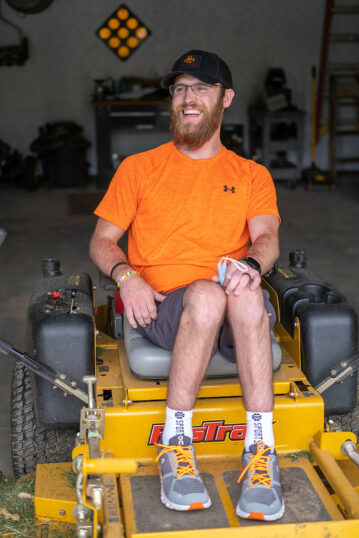 beside the building and mowed. This practice didn’t just aid Matt physically and get him back a bit at a time to doing what he loved, but it also allowed him to truly see the progress he was making.
beside the building and mowed. This practice didn’t just aid Matt physically and get him back a bit at a time to doing what he loved, but it also allowed him to truly see the progress he was making.
He wouldn’t have to sit aside and have someone else mow—he had the strength, drive, and capability to do it himself.
Coupled with Matt’s therapy gains—it became clear that Matt would not have to look out of a window at someone else mowing, and, as he jokes, doing it incorrectly.
Not only did Matt contend with rebuilding strength through therapies and activities, but he was also challenged with the navigation of life following a heart transplant and the medical precautions it brings. For both Matt and Kendra, another unknown to consider was stressful.
Fortunately for the Koppens, Matt had Kevin Wood, his primary nurse at QLI.
“Kevin made it clear from the start just how supportive he would be,” says Matt. “No matter where I was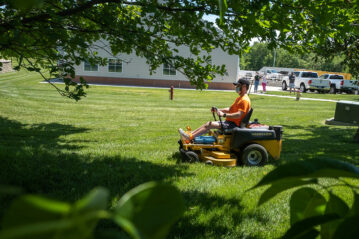 at—in the Gait Lab, by the lake, or in the shop, he’d be there ready to address any medical concerns I had.” Beyond providing Matt with the many medications he took on a daily basis, Kevin checked to make sure Matt wasn’t overexerting himself and putting undue stress on his new heart—any shortness of breath or chest problems meant that he would have to stop activity in a session. And if things like lab draws were necessary, Kevin would set up a time with Matt to collect what was needed, and send it off campus to be tested, rather than making a trip with Matt off campus for the tests, which may have taken unnecessary time away from his therapy sessions.
at—in the Gait Lab, by the lake, or in the shop, he’d be there ready to address any medical concerns I had.” Beyond providing Matt with the many medications he took on a daily basis, Kevin checked to make sure Matt wasn’t overexerting himself and putting undue stress on his new heart—any shortness of breath or chest problems meant that he would have to stop activity in a session. And if things like lab draws were necessary, Kevin would set up a time with Matt to collect what was needed, and send it off campus to be tested, rather than making a trip with Matt off campus for the tests, which may have taken unnecessary time away from his therapy sessions.
Kendra, also a nurse, was concerned that, like at the prior hospitals Matt had been treated at, his nurse would be different every day—meaning the lengthy medications, treatments, and concerns, would have to be relearned by every incoming nurse. Kevin was a constant of care for Matt, and Kendra noted that “we don’t have to worry anymore.” Kevin provided the Koppens with the knowledge they needed for the future.
Another crucial cornerstone of recovery is the client’s mental and emotion wellbeing. Chad Arnold, a QLI client in 2018, returned to campus as a mentor and joined the team as a Life Path Specialist in 2022.
For Matt, meeting with Chad multiple times a week provided confidence in his own life. Now, he has a 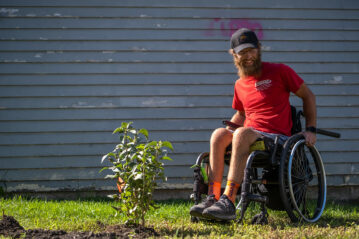 base of support that is far reaching—rooted not only in family, but his peers who can relate to his situations and the complex emotions that come along with it. After discharging, Matt made the decision to become a QLI mentor and give back to others what he was given.
base of support that is far reaching—rooted not only in family, but his peers who can relate to his situations and the complex emotions that come along with it. After discharging, Matt made the decision to become a QLI mentor and give back to others what he was given.
The question remained—“What will life truly look like?”
Their community of Whittemore, a town of less than 500 people, answered their question. They turned what would’ve been Matt and Kendra’s wedding reception into a fundraiser benefit. Nearly 1000 people turned out, with all of their well wishes fully behind the Koppens.
He can thrive on his own terms.
As a husband.
As a dedicated community member.
As a QLI mentor.
As a warrior.
